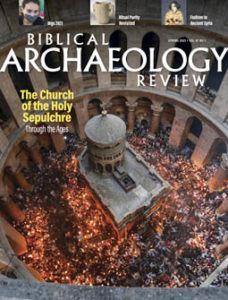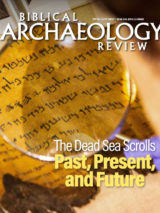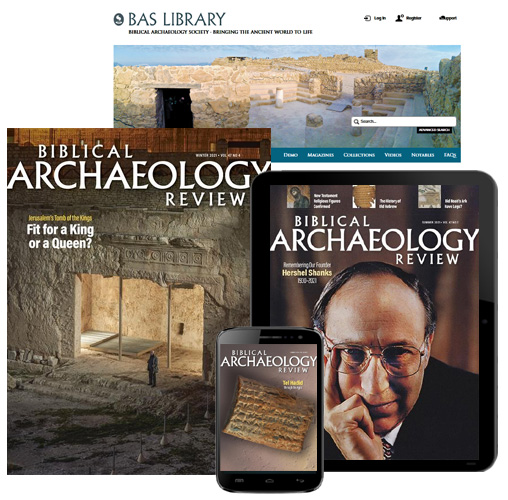Investigating the Church of the Holy Sepulchre
5 transformations of the site of the Holy Sepulchre
 Take a pilgrimage to the Church of the Holy Sepulchre, the holiest site in Christendom, in the Spring 2021 issue of Biblical Archaeology Review. Situated in the northwestern section of Jerusalem’s Old City, the church commemorates the traditional location of Jesus’s death, burial, and resurrection. With 22 chapels, a crypt, and many other features, the church complex covers a total area of roughly 1.25 acres and rises 112 feet at its highest point.
Take a pilgrimage to the Church of the Holy Sepulchre, the holiest site in Christendom, in the Spring 2021 issue of Biblical Archaeology Review. Situated in the northwestern section of Jerusalem’s Old City, the church commemorates the traditional location of Jesus’s death, burial, and resurrection. With 22 chapels, a crypt, and many other features, the church complex covers a total area of roughly 1.25 acres and rises 112 feet at its highest point.
In his article “The Holy Sepulchre in History, Archaeology, and Tradition,” published in the Spring 2021 issue of Biblical Archaeology Review, Justin L. Kelley examines recent archaeological investigations at the Church of the Holy Sepulchre. He also walks readers through the relevant texts to reconstruct the site’s rich history. From execution spot to magnificent church, it has gone through quite the transformation! For Bible History Daily readers, we have highlighted five major phases of its history.
(1) Quarry
Before there was ever a church in this location, there was a stone quarry. Standing outside the walls of ancient Jerusalem, the stone quarry stretched about 660 by 493 feet. It seems to have functioned sporadically during the first millennium B.C.E. and first century C.E.

The entrance to the Church of the Holy Sepulchre in the morning light on July 22, 2017. Photo by Megan Sauter.
Excavations reveal that as early as the eighth–sixth century B.C.E., the quarry was also used as a burial site. An Iron Age rock-cut tomb (dated to the eighth–sixth century B.C.E.) and two burial caves from the first century C.E. have been uncovered. According to the Bible, this area was also used as an execution site called Golgotha (“Place of the Skull”) in the first century C.E.
(2) Hadrianic Temple
After Jesus’s lifetime, Jerusalem witnessed two major Jewish revolts against Roman rule. Rome retaliated, burning the city and Temple in 70 C.E. and transforming Jerusalem into a Roman city, renamed Aelia Capitolina, in 130 C.E. During the development of Aelia Capitolina, the Roman emperor Hadrian built a temple at the site of the old quarry. This temple was likely dedicated to the Roman goddess of luck, Fortuna.
(3) Constantinian Church of the Resurrection
In the fourth century C.E., the Roman emperor Constantine, who had converted to Christianity, authorized the demolition of the Hadrianic temple and the construction of a church to commemorate Jesus’s resurrection. According to the Christian historian Eusebius, Constantine’s engineers discovered a rock-cut tomb. They separated it from the surrounding bedrock and built a structure around it. Known as the Edicule, this structure protects what traditionally has been revered as the tomb of Jesus, the site of his burial and resurrection.
They then built a magnificent church around the Edicule. It was named the Church of the Resurrection.
(4) Eleventh-Century Reconstruction
In the early 11th century, the Church of the Resurrection was destroyed. This act followed Fatimid Caliph al-Hakim’s order to demolish Christian and Jewish religious buildings in Jerusalem. He reversed his position a decade later and permitted these structures to be rebuilt. Between 1020 and 1047, Christians reconstructed the Church of the Resurrection, but this edifice was much smaller than the earlier church.
(5) Church of the Holy Sepulchre—12th-Century Reconstruction
The destruction of the Church of the Resurrection in the 11th century contributed to the instigation of the First Crusade—a European Christian military campaign to remove the Holy Land from Muslim control. In 1099, the Crusaders succeeded in setting up a kingdom with Jerusalem at its center. In the 12th century, they expanded and beautified the church, thereby restoring some of its earlier grandeur. They renamed it the Church of the Holy Sepulchre.
Although control of Jerusalem and the Holy Land has changed many times in the past millennium, the Church of the Holy Sepulchre has changed very little since the 12th century. Elements, including the Edicule, have been repaired and restored—with the most recent restoration taking place in 2016–2017. Nevertheless, the church’s form has largely remained the same.
These five transformations are just a part of the church’s rich history. Learn more in Justin L. Kelley’s article “The Holy Sepulchre in History, Archaeology, and Tradition,” published in the Spring 2021 issue of Biblical Archaeology Review. Additionally, Justin L. Kelley prepared a detailed plan of the church complex, available on Bible History Daily. For anyone planning to visit the Church of the Holy Sepulchre, this plan is an invaluable resource.
Become a Member of Biblical Archaeology Society Now and Get More Than Half Off the Regular Price of the All-Access Pass!
Explore the world’s most intriguing Biblical scholarship
Dig into more than 9,000 articles in the Biblical Archaeology Society’s vast library plus much more with an All-Access pass.

Read more in The BAS Library:
Not a BAS Library or All-Access Member yet? Join today.
Exhibit Watch: Restoring the Church of the Holy Sepulchre
The traditional location of Jesus’s death and burial, the Church of the Holy Sepulchre is one of Jerusalem’s most visited sites. Despite its revered status, the church has not been immune to the ravages of time—or destruction from direct attacks and fires. Originally constructed in the fourth century C.E., the Church of the Holy Sepulchre has undergone numerous expansions and repairs—most recently in 2017.
The Evolution of a Church—Jerusalem’s Holy Sepulchre by J. P. B. Ross
Father Charles Couäsnonwas already a practicing architect when he entered the Dominican Order of Preachers. Since 1954, he has been actively engaged in the restoration work of the Church of the Holy Sepulchre in Jerusalem, aimed at repairing the extensive damage caused to the church by fire in the 19th century and by earthquake in the 20th.
Does the Holy Sepulchre Church Mark the Burial of Jesus? by Dan Bahat
In connection with the restoration, they have undertaken extensive archaeological work in an effort to establish the history of the building and of the site on which it rests. Thirteen trenches were excavated primarily to check the stability of Crusader structures, but these trenches also constituted archaeological excavations.
Ancient Gold Ring Depicts the Holy Sepulchre by Yaakov Meshorer
A gold ring was found in 1974 in the excavations south of the Temple Mount in Jerusalem.a At the time, the suggestion that the ring depicted the Holy Sepulchre, or tomb of Jesus, met with considerable scholarly skepticism. The ring has never been studied or published. My own view is that the structure on the ring does in fact represent the Holy Sepulchre.
Must-Read Free eBooks
Want more Bible history?
Sign up to receive our email newsletter and never miss an update.
All-Access Pass
Dig into the world of Bible history with a BAS All-Access membership. Biblical Archaeology Review in print. AND online access to the treasure trove of articles, books, and videos of the BAS Library. AND free Scholar Series lectures online. AND member discounts for BAS travel and live online events.
Subscribe Today








